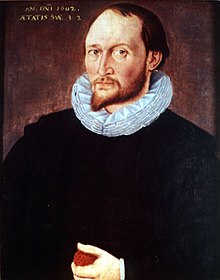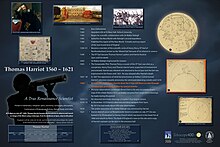Thomas Harriot
Thomas Harriot (* 1560 in Oxford ; † July 2, 1621 in Sion House near Isleworth , Surrey ) was an English mathematician , natural philosopher and astronomer . He founded the English School of Algebra .
Life
According to his matriculation in Oxford in December 1577, his father was a commoner , that is, he belonged to neither the nobility nor the priesthood. In his Testament of 1621 he called a sister and a cousin, and that is all that is known of his family. In addition to the classical curriculum at Oxford, he probably also heard Richard Hakluyt on the geography of the New World and was perhaps recommended by him to Sir Walter Raleigh , in whose service he entered in 1583. There he taught a. a. Navigation in preparation for the settlement experiment on Roanoke Iceland under Sir Richard Grenville , where Harriot attended. In 1588 he published a book A brief and true report of the new found land of Virginia . When Raleigh was locked in the Tower in 1592 , Harriot changed patron in the guise of Henry Percy , 9th Earl of Northumberland, a friend of Raleigh. From him he received a high pension and some estates in Durham, which made him a member of the low land nobility (he also owned properties in Cornwall and Norfolk). He lived on his estate at Sion House (or Syon House) near Kew on the Thames outside London for the rest of his life. There he also made his astronomical observations. In 1593 he himself got into trouble when the already famous poet and dramatist Christopher Marlowe was to be tried for atheism , whereby the name Harriot was mentioned in a statement by an informant (so-called Baines Notes) about Marlowe. Marlowe's striking death at the same time, which had nothing to do with his charge of atheism, prevented the trial. During this time he is said to have belonged to the “ School of the Night ”, a group of critical intellectuals and aristocrats. In 1604, Harriot was also drawn into the Gunpowder plot . His patron's cousin, Percy, had rented the space under Parliament where the powder load was stacked. The Earl came to the Tower from 1605 to 1621, but Harriot himself was only briefly imprisoned - he was accused of having put a horoscope over King James I.
Harriot died in 1621 of nasal cancer from which he suffered for a long time. A plaque on the Bank of England commemorates his grave, which fell victim to the Great Fire of London in 1666 .
He bequeathed his posthumous writings to Henry Percy and entrusted the editing to Nathaniel Torporley and Walter Warner .
plant
As a mathematician he researched equations, found important relationships between coefficients and roots and in 1603 the content formula for the spherical triangle . In Harriot's Artis analyticae praxis , published posthumously in 1631, the comparison signs = (equal), <(less than) and> (greater than) also appear; therefore its introduction is attributed to Harriot. In fact, he used a different spelling in the rough version, which was probably written around 1610, so that the character spelling can perhaps also be traced back to the editor of the book.
The earliest treatment of the dual system (and also of number systems on a different basis such as 3 or 4) in Europe was found in his estate, but Harriot saw no use in it.
In connection with work on map drawing, he was the first to recognize the angular accuracy of stereographic projection in 1590 . In the same year he was also one of the first to calculate an arc length (for the curve, which is important as a loxodrome in navigation). Interpolation formulas (the initial terms of the Newton-Gregory formulas) were also found in his papers, which Briggs may have used shortly afterwards for his log tables.
As an astronomer, Harriot was the first to use the telescope for scientific celestial observation. On August 5, 1609 (July 26, 1609 according to the Julian calendar ) he made the first surviving drawings of the lunar surface and studied the four brightest Galilean moons of the planet Jupiter and was a few months ahead of Galileo . Harriot remained relatively unknown because he had not published his astronomical drawings. To mark the 400th anniversary of these moon drawings, a plaque was inaugurated in Syon House in London in 2009.
Harriot was probably the first to discover sunspots . This emerges from a bibliographic discovery made by the German astronomer Franz Xaver von Zach . In 1786 he found manuscripts by Thomas Harriot. This contains 199 spot drawings, the first of which was on December 3rd . / December 13th 1610 greg. was made. However, these first drawings were not published by Harriot, so Johann Fabricius was the first to publish the existence of sunspots in a scientific paper. Often, however, Galileo Galilei is viewed as an explorer because his message was widely circulated in the pamphlet " Star Messengers" .
Harriot discovered the law of refraction of light as early as 1601 , before Willebrord Snell (1621, published by René Descartes 1637), but failed to publish his discovery here as well.
He was involved in a single expedition to the New World , from 1585 to 1586 he spent some time on Roanoke Island off the coast of North Carolina . Here he expanded the general knowledge of the Algonquin by improving the understanding of the Algonquin language . As the only Englishman on the expedition, he learned the Algonquin before the trip.
He did not publish anything during his lifetime. His algebra book Ars analytica praxis was published in 1631, but the editors omitted parts that were incomprehensible to them (such as negative and complex solutions to algebraic equations). An English translation with annotation was published in 2007. Part of the estate is in the British Museum and in the Percy family archives at Petworth House in Sussex and Alnwick Castle in Northumberland . In 2009 the asteroid (5548) Thosharriot and in 2015 the exoplanet Harriot was named after him. He has been the eponym for the Hariot Glacier [sic] in Antarctica since 1962 and for the Harriot lunar crater since 1970 .
literature
- Harriot Artis analyticae praxis (dt. Praxis der Rechenkunst ), published posthumously in 1631, English translation edited by Muriel Seltman, Robert Goulding Thomas Harriot's Artis analyticae praxis , Springer 2007, Sources and Studies in the History of Mathematics and Physical Sciences
- J.Shirley Thomas Harriot- a biography , Clarendon Press, Oxford 1983
- John William Shirley (Ed.): Thomas Harriot, Renaissance scientist, Clarendon Press, Oxford 1974 (Symposium University of Delaware 1971)
- John William Shirley (Ed.): A sourcebook for the study of Thomas Harriot, New York: Arno Press 1981
- Henry Stevens: Thomas Hariot, the mathematician, the philosopher and the scholar, New York: Franklin 1972 (originally published in 1900)
- Stillwell Mathematics and its history , 2nd ed., Springer 2002
- Lohne Thomas Harriot as a mathematician , Centaurus Vol. 11, 1965, pp. 19–45
- and Essays on Thomas Harriot 1-3 , Archive Hist. Exact Sciences Vol. 20, 1979, pp. 189-312
- Matthias Schemmel: The English Galileo. Thomas Harriot's Work on Motion as an example of preclassical mechanics , Springer Verlag 2008 (Dissertation Humboldt University Berlin)
- R. Kargon Atomism in England from Hariot to Newton , Oxford 1966
- Robert Fox (Ed.): Thomas Harriot and His World: Mathematics, Exploration, and Natural Philosophy in Early Modern England, Oxford, Ashgate 2012
- Robyn Arianrhod: Thomas Harriot: a life in science , Oxford; New York, NY: Oxford University Press, [2019], ISBN 978-0-19-027185-5
Rosalind Tanner organized annual research symposia on Harriot from 1967 in Oxford and Durham.
Web links
- Literature by and about Thomas Harriot in the catalog of the German National Library
- Publications by and about Thomas Harriot in VD 17 .
- John J. O'Connor, Edmund F. Robertson : Thomas Harriot. In: MacTutor History of Mathematics archive .
- The Thomas Harriot Seminar
- Thomas Harriot's Moon Drawings (English)
- Thomas Harriot Online - The Manuscripts of Thomas Harriot (1560-1621)
- Spektrum .de: Thomas Harriot (1560–1621) May 1, 2015
Individual evidence
- ↑ Karen O. Kupperman: Roanoke. The abandoned Colony. Rawman & Littlefield, 1984, ISBN 0-8476-7339-1
- ↑ Archived copy ( memento of the original from January 12, 2012 in the Internet Archive ) Info: The archive link was inserted automatically and has not yet been checked. Please check the original and archive link according to the instructions and then remove this notice.
- ^ Susanne S. Webb, Raleigh, Hariot, and Atheism in Elizabethan and Early Stuart England, Albion: A Quarterly Journal Concerned with British Studies 1969
- ^ Robert Ineichen: Leibniz, Caramuel, Harriot und das Dualsystem , Mitteilungen DMV, Vol. 16, 2008, p. 12, Shirley Binary numeration before Leibniz , American Journal of Physics, Vol. 19, 1951, p. 452
- ^ Galileo Project, Harriot Moon Drawings
- ^ Giles Milton; Elizabeth Big Chief: How England's Adventurers Gambled and Won the New World. Hodder & Stoughton, London 2000, p. 89
- ↑ Thomas Harriot at the IAU Minor Planet Center (English)
- ↑ Thomas Harriot in the Gazetteer of Planetary Nomenclature of the IAU (WGPSN) / USGS
| personal data | |
|---|---|
| SURNAME | Harriot, Thomas |
| BRIEF DESCRIPTION | English mathematician, natural philosopher and astronomer |
| DATE OF BIRTH | 1560 |
| PLACE OF BIRTH | Oxford |
| DATE OF DEATH | July 2, 1621 |
| Place of death | at Isleworth , Surrey |


